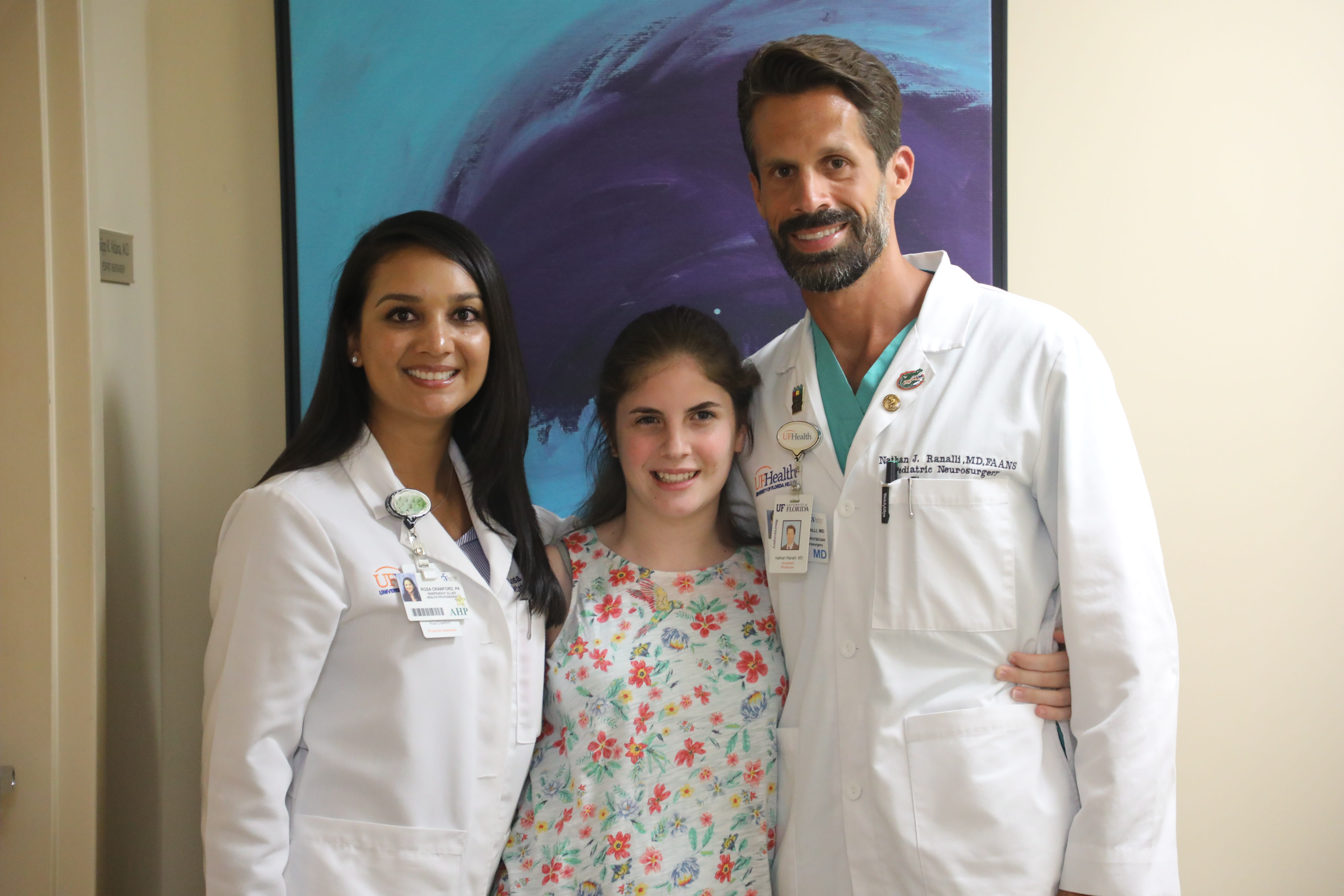Spinal surgery helps teen get moving
Cerebral palsy left Chloe with trouble walking, but a minimally invasive surgery is changing that.
Article Date:

At 34 weeks pregnant, Melanie Provenza noticed her baby was much more active than usual. She didn’t worry too much about it, but would later find out her baby, Chloe, wasn’t just feeling playful that day - she was having a stroke in the womb.
“In many cases we don’t know the definitive cause of ischemic stroke in newborns,” said Nathan Ranalli, MD, pediatric neurosurgeon with the Stys Neuroscience Institute at Wolfson Children’s Hospital and the UF College of Medicine – Jacksonville. “Chloe suffered an area of stroke on the left side of her brain, and that resulted in the opposite side of her body being weak and developing spasticity. She was also affected by hydrocephalus, which resulted in needing a shunt as a baby.”
Today Chloe is 14 years old, a rising eighth grader who loves reading, singer Ed Sheeran and going to equine therapy. She has cerebral palsy — a disorder affecting movement or muscle tone caused by damage to the developing brain — as a result of her stroke before birth. Like many children with cerebral palsy Chloe has experienced muscle spasticity, meaning some of her muscles are constantly tightened and restrict her movement. Chloe’s right arm was weak and her right leg’s muscles were so taut she couldn’t straighten her knee, making it difficult to walk.
“It was like she was a statue,” Provenza said. “She wasn’t able to sit cross-legged. She couldn’t participate in activities with climbing or that required her to maneuver herself around. It was hard just playing games and keeping up with other kids.”
For most of her life, Chloe has been a patient of Eric Loveless, MD, pediatric orthopedic surgeon at Wolfson Children’s and Nemours Children’s Health. He has performed numerous surgeries to repair damage to Chloe’s joints caused by her spasticity. Also managing her spasticity was Louise Spierre, MD, pediatric physiatrist with the UF College of Medicine – Jacksonville.
“Our goal is to get patients to their highest possible functional level and improve their comfort,” said Dr. Spierre. “We’ve been involved in Chloe’s care for years. We provided nonsurgical management of her spasticity and we closely monitored her progress with interventions. If a patient isn’t progressing, we meet as a team and discuss further interventions. This team-based approach is what really differentiates our spasticity care program.”
Physical medicine and rehabilitation, orthopedic and neurosurgical specialists all met to discuss Chloe’s case. After the team discussion and speaking with Chloe about her goals, her doctors referred her to Dr. Ranalli for a specialized procedure they felt would finally improve her spasticity — selective dorsal rhizotomy (SDR).
During SDR, surgeons make a small incision in the back, and remove a small amount of bone from the base of the spine to expose the point where all of the nerves are bundled within the spinal column. Then, each sensory nerve between vertebra L1 and S1 is stimulated with a small electrical signal to determine which ones serve which muscle groups, and about 50 percent of the ones connected to spastic muscle groups are snipped.
“In kids with spasticity, the body’s ability to regulate how the muscles contract has been altered,” said Dr. Ranalli. “Our goal is to interrupt that abnormal sensory input. We carefully select and cut 50 to 60 percent of the sensory roots causing the most spasticity. This is the magic number to give more control without numbness.”
Learning more about spasticity
Melanie and Chloe started doing their research. Spasticity affects many children with cerebral palsy, and within that community, one doctor’s name kept coming up: Dr. T.S. Park. Dr. Park pioneered a minimally invasive version of SDR that very few neurosurgeons in the country can perform. Dr. Ranalli trained under Dr. Park in St. Louis and offers the same procedure here in Jacksonville. U.S. News & World Report also ranks Wolfson Children’s Hospital among the top 50 hospitals in the nation pediatric neurology and neurosurgery, making it an ideal place for Chloe to undergo an otherwise intimidating surgery.
“This was her 12th surgery,” said Provenza. “All of them were related to her spasticity. I was scared to death because this time it involved her spine, but I trusted Dr. Ranalli. I researched a lot through speaking with Dr. Park and his team, who specialize in this.”
“I was able to adopt the evidence-based techniques and processes from that training, including a smaller incision, less bone removed and intense physical therapy that goes on for about a year after the surgery,” said Dr. Ranalli.
After some deliberation, Chloe and her parents decided SDR was right for her. She recovered in the Pediatric Intensive Care Unit at Wolfson and began physical therapy with Wolfson Children's Rehabilitation three days after her surgery.
“Following SDR we see a pretty quick reduction in spasticity,” said Dr. Ranalli. “Patients like Chloe have muscles that were once very tight and spastic, but have become kind of floppy and look weak. Then comes physical therapy to get stronger and help their bodies learn to use those limbs again.”
An amazing recovery
After just three weeks, Chloe and her mom could already see a difference.
“She couldn’t straighten her knee before, but now she’s just shy of it being able to hold it perfectly straight,” said Provenza. “She can actually bend her leg at the knee and sit crisscross. Walking will get a lot easier as she continues to strengthen her leg and is able to lift her foot up when she’s walking. Hopefully this will take away the discomfort of being so tight all the time.”
Chloe will undergo extensive therapy physical therapy four days a week for at least six months, and may continue for a year or longer depending on her needs.
“In many cases, the full benefits aren’t realized for six months to a year after the procedure,” explained Dr. Ranalli. “We’re always happy when kids seem to do well within a few weeks, but more change is expected the further out you get. When we sign patients up for surgery, we’re asking families to sign up for an extended physical therapy regimen too, otherwise their child is not going to benefit.”
Chloe and her mom are glad to have had access to minimally invasive SDR in their hometown of Jacksonville, and are happy it was available where she was already comfortable at Wolfson Children’s Hospital.
“Wolfson Children’s Hospital has been incredible,” said Provenza. “It’s important to me that she has these great relationships with her doctors and they treat her like one of their kids. They all love her and treat her very kindly. She had never met Dr. Ranalli before this, but she took to him very quickly. And the nurses are just wonderful. When we were moved to the 5th floor, her nurses from the PICU came up to visit her. They would sit with her, talk with her and hug her. One of the employees from the lunchroom even brought her cake for her birthday.”
Dr. Ranalli added, “The potential for Chloe is great because she’s very intelligent and very hardworking. You need to be able to engage in pretty intense physical therapy after surgery, so those qualities made her a great candidate for the surgery.”
Visit wolfsonchildrens.com/spasticity for more information about the management of cerebral palsy and spasticity.



